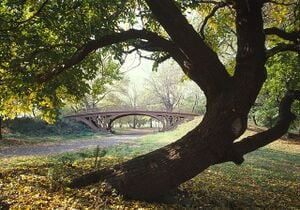
This page is the beginnings of a portal for New York City community action in response to Ecological emergency.
Biodiversity[edit | edit source]
New York City Audubon - The Welikia Project, Ecology of pre-1609 New York City
Environment quality[edit | edit source]
wikipedia:Environmental issues in New York City are affected by the city's size, density, abundant public transportation infrastructure, and location at the mouth of the Hudson River. New York's population density has environmental pros and cons. It facilitates the highest mass transit use in the United States, but also concentrates pollution. Gasoline consumption in the city is at the rate the national average was in the 1920s, and greenhouse gas emissions are a fraction of the national average, at 7.1 metric tons per person per year, below San Francisco, at 11.2 metric tons, and the national average, at 24.5 metric tons. New York City accounts for only 1% of United States greenhouse gas emissions while housing 2.7% of its population. In September 2012, New York was named the #1 "America's Dirtiest City," by a Travel+Leisure readership survey that rated the environmental quality of 35 prominent cities in the United States.
Open spaces[edit | edit source]
- Bronx River Alliance, Video: Bronx River Alliance channel on youtube.com
- Design Trust for Public Space, nonprofit organization dedicated to the future of public space in New York City. "Our projects bring together city agencies, community groups and private sector experts to make a lasting impact — through design — on how New Yorkers live, work and play.[1]
- The High Line & Friends of the High Line (Wikipedia) The High Line is a 1-mile (1.6 km) New York City linear park built on a section of an elevated former New York Central Railroad spur, redesigned and planted as an aerial greenway
- People Make Parks supports community groups to contribute to NYC Parks' building and design process
Wikipedia:Parks and recreation in New York City: Major municipal parks in New York City include Central Park, Prospect Park, Flushing Meadows-Corona Park, Forest Park, and Washington Square Park. The largest is Pelham Bay Park, followed by the Staten Island Greenbelt. City Parks Foundation offers more than 1200 free performing arts events in parks across the city each year. The city has 28,000 acres (113 km²) of municipal parkland and 14 miles (22 km) of public municipal beaches.
